The Lawmatics Blog
Insights on legal marketing, automating the law practice, and legal tech in general
About the session
Behind every great client experience is a system quietly keeping things on track. The newest automation updates in Lawmatics build on that foundation, making it even easier to build and manage their automated workflows.
In this session, Devon Butler and Clare Struzzi walk step-by-step through what’s new. They cover trigger-based automations, appointment workflows, shared entry rules, and a simple way to organize everything in folders. Together, these improvements give firms even more control, flexibility, and time back in their day.
Webinar slide deck

Your next clients are online right now searching for answers to their life-legal problems. Whether they're researching specific questions related to their issue, or looking for the right lawyer to handle their situation, most of these searches will involve Google. In this webinar Lawmatics founder and CEO Matt Spiegel welcomed Gyi Tsakalakis, president and cofounder of digital legal marketing agency AttorneySync.
Time stamps of key takeaways
0:00 — Introductions
How do people find lawyers? More and more, the answer is search engines like Google. Matt and Gyi introduce themselves and why search engine optimization is an essential building block for a law firm’s marketing strategy.
18:40 — How google works
Before getting into the mechanics of how Google chooses which results to show, it’s first important to understand how Google presents its results. Gyi breaks down the anatomy of a Google search results page, including how Google prioritizes and presents ads, organic traffic, and a local pack of relevant and prominent results for an inquiry.
23:54 — How to rank in Google’s traditional organic results
Traditional organic results on Google contain four key elements. Along with the result’s URL and title, Google shows meta descriptions and structured data. Meta descriptions are brief blurbs summarizing the content of the result. Structured data contains additional information related to the result, like a drop-down list of frequently asked questions. In this section, Gyi discusses how these components work together to create a relevant search result.
27:00 — How to earn links
The more people link to your website, the more prominent your website will be in search results. Here, Gyi gives some tips on how to earn more links to increase your site’s prominence.
38:10 — How to rank in Google’s local pack
In addition to prominence, local search results are determined by relevance and dominance. Relevance is how Google knows not to show results for plumbers when you search for electricians. Calculated distance considers how far a potential search result is from the location term used in a search. Gyi shares some thoughts on how these factors are weighted in local and organic searches.
50:24 — Other search features
Explicit searches are only one slice of the Google pie. Along with searching terms like “Michigan personal injury firm,” users search for law firm reviews and general legal questions. This section comes with thoughts on moderating reviews and including them in your structured data, and the role of blogs and thought leadership content in addressing general questions.
57:24 — A process for earning organic traffic
You won’t optimize your firm’s search results on Day One. That’s not only okay, it’s expected. Search engine optimization is a continuous process. Here are some things to keep in mind as you embark on this journey, along with some suggested priorities.
Webinar slide deck
Law firms work hard to attract new leads. After all, clients are the lifeblood of a law practice, and lawyers are constantly on the lookout for new cases. But when a lead becomes a prospect and a prospect turns into a potential client, it’s only the beginning. Everything comes down to one make-or-break event – the in-person initial client consultation. Here are 9 tips to help ensure that this meeting is not simply a one-off, but rather, signals the beginning of a successful attorney/client relationship:
1 Get to know the client and their case
Lawyers are often so intent on securing a new client that they overlook warning signs that a particular client might not be a good fit for them. For instance, has the client retained multiple lawyers prior to coming to you and was generally unhappy with their performance? Although many of us like to think we can work with anyone, truthfully, this might be a client who no one can satisfy. Similarly, does the client have unrealistic expectations? Clients sometimes seek legal counsel to get revenge on someone that they feel has wronged them but their case does not have merit. Once you tell them that they do not have a cause of action, the hope is that they will adjust their expectations accordingly. However, if they don’t, they are likely not the right client for you.
2 Be an active listener
Instead of viewing communication as getting your own point across, think of it as a two-way street where active listening is critical. Ask questions for clarification, give the conversation your complete attention, and avoid framing your response while the person is still talking. Although it can sometimes be challenging, active listening can be extremely beneficial. To avoid feeling rushed or pressured, try to schedule some extra time for the meeting.While lawyers routinely handle matters within their area of practice, they need to remember that this might be the client’s first and only legal dispute and could be the first time they’ve stepped into an attorney’s office. Instead of bragging about expanding caseloads at the initial meeting, it is more important to listen to the client’s concerns and take the time to answer their questions. A client will value your insight and advice more than your popularity, and will appreciate your focus and attention.
3 Set the expectations
No one likes surprises, especially from an attorney. That is why it is critical to let the client know what to expect from you at the first meeting. If you have staff that will work on the case, let the client know their names and roles in the representation, and arrange a meeting with them if possible. If you don’t plan on being involved in the day-to-day management of the matter, let them know that as well. Give the client information about your fees, retainer obligations, billing policies, and let them know the preferred ways to communicate with you – phone, email, text, etc. – and how quickly you will respond to their inquiries. Also find out what is the best way for you to get in touch with them. With this exchange of information, the client knows what to expect and will be prepared to proceed accordingly.Never make promises you might not be able to keep. Try to estimate and manage their expectations regarding the success of their case, reminding them that the final outcome will depend on a variety of factors, many of which are beyond your control. Never build up unrealistic expectations. As useful as the initial consultation can be, don’t make the mistake of relying too heavily upon it. As the case unfolds, you will likely find it necessary to reassess your client’s ever-changing emotions and expectations. This will put you on the offensive rather than the defensive and enable you to leverage what you learn from your client to improve the quality of your representation.
4 Describe the process
Your prospective client will appreciate knowing exactly what to expect — not only in terms of procedure but your office’s billing and staffing policies as well. Understanding how the legal process works will help them know what to expect in the way of forms, court appearances, etc., and knowing how their case will be worked will give them peace of mind to know the extent of your involvement in the case. Since a major source of client anxiety is fear of the unknown and many clients have little or no experience with the legal system, you can enhance the relationship by patiently guiding them through the process. After you retain them as a client, continue to provide genuine reassurance and plenty of one-on-one attention to ensure that they thoroughly understand what is happening with their case. Clients who trust their lawyers are typically easier to work with than those who don’t, and it is important to earn and nurture their trust, particularly when their stress levels are elevated.
5 Prioritize convenience
One of the biggest hiccups of the client intake process is getting documents signed and returned. Asking your clients to print, sign, scan, and send documents back to you can be a burden, but the easier you can make it for them, the more likely they are to be happy with your services. There are numerous ways that technology can dramatically streamline the client experience. For example, you can give clients the opportunity to book their own appointments with legal calendaring software. If clients can easily schedule and cancel meetings themselves, it will keep everyone on the same page and on time. Instead of asking them to take multiple steps to get an important document back to you, allow them to sign electronically. Electronic signature for legal documents is an alternative and hassle-free way to sign documents. You can get the ball rolling much faster since clients can sign and send documents back to you from any device with an internet connection. Convenience is key.
6 Take a team approach
Let the client know that the attorney-client relationship is reciprocal. You will educate them on the law and guide them through the process, but they will be required to participate in the decision-making process. Encourage them to be honest and upfront with you so that you can help them make informed and wise choices. Clients typically appreciate having some control over their legal matters and their own destiny.While critical to growth, the initial consult should not be viewed as a win-or-lose situation. Rather, it should be seen as an opportunity to tell a potential client what you can offer as their lawyer – and what they should expect as your client. Assuming that you’ll be able to function as a team, the likely outcome will be a successful relationship.
7 Talk specifics
While discussing knowledge of the law is critical to retaining the client, most do not schedule an appointment to be schooled in law but rather to receive an educated opinion about their legal matter. While it is necessary for a lawyer to spend time understanding the facts of the case, to save time, many attorneys have a prospective client bring a completed questionnaire to the initial meeting or have a staff member help the client complete this document. Although it is more time-consuming, it is better if the lawyer completes this intake form with the client. This way, the lawyer will get a sense regarding issues that are most important to the client. When the lawyer has a full understanding of the relevant facts of the case, they will have the opportunity to ask questions to derive the most important information.
8 Be transparent about fees
No initial meeting can be concluded without a discussion of cost. While a lawyer is hard-pressed to estimate the total cost of the legal matter, billable rates, minimum amounts of time billed, and the frequency of billing are key issues that the prospective client needs to understand.With legal billing software, your legal team can share invoices with clients in a way that’s easy for them and efficient for you. Whether it’s via a secure client portal, secure email, or by traditional mail, this technology will enable you to review bills and share client invoices via your preferred method of delivery in just a few clicks.
9 Answer their questions
After you understand the facts of the case and inform the prospective client of all possible outcomes, it is important that you allow sufficient time for them to ask questions. At the beginning of the consultation, you should let the client know that you will likely answer many of their questions during the course of the meeting, but time will be reserved at the end of the consultation for their questions. This will help put the client at ease so that they can listen intently to what they are being told, knowing that at the end of the meeting, they will have time to ask questions and voice concerns.
Questions you should ask
Here are some interview questions you should ask potential clients, and why asking them matters:What brings you here today? Of the dozens of lawyers in your area, this potential client decided to contact you. From a marketing standpoint, you need to know how this client was attracted to your firm so that you can do more of this type of promotion. Their answer could also provide valuable insight into what is important to this person, where they go for answers, and how they approach problem solving.Have you worked with an attorney before? If this is the first time the potential client has had a meeting with a lawyer, if you decide to offer representation, you’ll need to explain what will be expected of them, how similar matters usually progress, when decisions will need to be made, and what the likely timeframe might be. Why did you decide to pursue this matter? This question will allow you to find out how serious the client is about bringing legal action and allow them to provide some valuable background that will help you prepare your legal arguments. Asking open-ended questions about their motivation for pursuing legal action will demonstrate your interest in their case and show them that you appreciate any information they can provide. How can I help? Asking this question will demonstrate your willingness to put their priorities ahead of your own. Instead of going into a client meeting with your own agenda, learn to ask questions that will help you learn about your client’s problem, a problem that only a lawyer can help them solve. Find out what is keeping them up at night.Tell me about your case. Instead of asking a series of standard questions about their potential legal matter, asking an open-ended question could very net you more valuable information. Pay close attention to what they reveal to you, and what you need to inquire further about – both can provide clues to this client’s priorities and what they might not want to be forthcoming about.How would you like to handle communication with our office? A one-size-fits-all approach to communication with clients is usually not a good approach. Some will want constant updates, others will appreciate occasional emails or texts, while still others might want to speak to you in person or via phone. You should also determine the frequency of communication – daily, weekly, monthly, or as needed.What concerns you most about your case? The answer to this question might reveal a lot about this potential client. If they say, “how much it is going to cost,” you’re likely dealing with someone who is going to want to know exactly how their money is being spent. If they say, “that I’ll lose the case,” you need to talk in depth about the strengths and weaknesses of the matter. If they express fear or intimidation, you’ll need to be prepared to explain the process step by step.What is your desired outcome? Clients decide to hire attorneys for many different reasons – to recover monetary compensation, make a statement, decipher a contract, get a divorce – and it’s important to find out what your client is hoping to accomplish. If merely collecting damages isn’t enough, you have to decide whether what this potential client is after is something that you can actually provide.
Sign more prospective clients with Lawmatics
Lawmatics all-in-one legal client relationship management (CRM) platform allows law firms to seamlessly move leads through the client intake process with custom, automated workflows. Our technology is designed to simplify the process and eliminate chaos while making a positive impression on your future clients. With our workflow automation software, you can capture leads, convert clients, and meet their expectations with personalized messages at the right time through the right channel. The Lawmatics system will help your firm:
- Collect information on potential clients from your website
- Follow-up with messaging tailored to their characteristics
- Onboard clients by offering value at the right time
- Gather client data to refine your messaging each step of the way
- Stop letting leads fall through the cracks
- Make the most of initial consultations and sign more clients
For more information on how our software will streamline your intake process so that you can maximize your initial consultations and win more clients, request your demo today.
In personal injury law, evidence is everything. Personal injury clients count on attorneys to help them recover losses from the harm they’ve suffered. There are numerous ways that personal injury attorneys gather evidence, and technology such as case management software or CRM for law firms helps them:
- Gather data. Mobile phones are helpful to those injured in a motor vehicle crash by allowing them to call 911 – the phone records the time of the call, which can be valuable evidence in a personal injury case.
- Record evidence. When a dashcam captures the scene of a motor vehicle accident, this video can be shown at trial to establish how the crash happened and who was at fault.
- Prove liability. When law enforcement takes a photograph of a license plate, the photo can be used as identifying information to prove liability.
- Manage cases. Personal injury case management software organizes client information, manages workflows, generates documents, handles billing, keeps files secure, and performs many other essential functions.
Case management software is a valuable tool for personal injury law firms of all sizes. It replaces paper files and client tracking in a spreadsheet on Excel, reduces human error, automates manual processes and repetitive tasks, establishes and maintains client engagement, and ensures that vital information is securely stored and easily accessible.
What is case management software for personal injury?
Personal injury case management software is technology customized to help personal injury attorneys manage their firms and build solid cases. Personal injury-specific platforms typically include custom forms and templates for various types of personal injury cases – medical malpractice, slip and falls, automobile accidents, workplace injuries, and more – as well as specific features like:
- Conflict checking
- Client intake automation
- Task management
- Appointments scheduling
- Automated appointment reminders
Because personal injury is a document-heavy area of practice, many of these platforms provide robust document management functionality and the ability to track deadlines and run reports that offer an overview of each case as it progresses. However, since most personal injury attorneys accept cases on a contingency basis, these systems may not include time-tracking functionality, instead focusing on tools to manage all stages of a case, including litigation.
What is the difference between CRM and case management software?
The main difference between case management software and legal CRM (customer relationship management) is that case management software is intended to streamline the internal operations of a law firm. At the same time, CRMs are professional marketing tools that focus on external communications, allowing attorneys to communicate with potential clients. However, some case management tools include lead management and customer relationship management features.Case management software helps firms automate and build systems around things like:
- Invoicing and bookkeeping
- Case records
- Client contact information
- Files and documents
- Critical deadlines
- Calendaring and appointments
CRMs are professional marketing tools that allow firms to:
- Build lists of prospects
- Categorize prospective clients
- Conduct drip email campaigns
- Track interactions with potential clients
- Use their website to collect contact information
- Visualize and manage their sales funnel
As law firms grow, they might eventually need both tools. However, case management software is typically a priority for growing firms.
Why do personal injury lawyers need case management software?
Case management software helps personal injury attorneys operate more efficiently. In general, these systems can help law firms:
- Reduce the risk of defending a legal malpractice claim
- Lower the firm’s malpractice insurance rate
- Streamline attorney-client communications
- Eliminate missed deadlines
- Reduce staff workload
Generally speaking, If a law firm isn’t using case management software, it might be wasting time and money compared to firms that have digitized their practice.
Features and benefits of personal injury case management software
Personal injury case management software automates repeatable processes, enabling firms to focus on clients. Here are some of the features and benefits of the most agile, cloud-based systems:
- Client intake forms allow users to capture intake data based on the type of case to save time and money and to reduce human error.
- Document automation that utilizes custom fields to merge data and contacts, then auto-fill directly into boilerplate legal forms with one click.
- Secure communication platforms to help attorneys find and send critical client information quickly and easily.
- E-signature capability to enable lawyers to quickly generate and securely deliver fee and retainer agreements to clients from anywhere to eliminate costly delays.
- File request builders that make it easy to find and send vital case files in seconds.
What software does a law firm need?
Lawmatics personal injury case management software gives clients the experience they deserve. Considered by many to be the premier legal CRM on the market, Lawmatics integrates with platforms like Clio and automates client follow-ups, email workflows, appointment scheduling, legal documents, client intake, and more for growing personal injury firms. To learn more, request a demo today.
Customer relationship management (CRM) systems can benefit businesses of all types, including law firms. These platforms can perform numerous critical activities that will streamline operations, improve efficiency, and keep everyone on track. In addition, CRMs play a major role in improving relationships with clients, leads, and customers.
Why do law firms need CRM, particularly personal injury firms?
Personal injury is a fast-moving, highly detailed, and document-heavy area of law. As a result, it can be easy to lose client information, important paperwork, and critical emails, leading to a scramble to locate essential data. However, legal CRM software helps personal injury law firms manage their interactions with current and potential clients. These platforms can do the following and much more:
- Automate client engagement to provide high-level customer service
- Eliminate the busy work that keeps teams from focusing on substantive legal work
- Streamline the intake process with customizable forms and welcome messages
- Update client data in real-time to eliminate errors
- Track tasks and deadlines to keep everyone on the same page
- Appointment reminders, to eliminate no-shows and delays
- Generate performance reports that track progress and identify areas for improvement
In today’s competitive legal environment, a CRM can benefit almost any law practice, particularly personal injury firms.
What exactly does a CRM do for personal injury lawyers?
A personal injury CRM automates repetitive processes to help legal teams focus on clients and their needs rather than push paper. The top personal injury CRMs typically provide the following:
- Custom intake forms that allow users to determine how they want to capture intake data based on the type of personal injury case. Customized forms create a clear and consistent system that saves time and human error to provide the firm and its clients much-needed reassurance.
- Contact management features that enable personal injury firms to keep track of clients in one central location. This capability provides transparency that keeps the entire team organized, up-to-date, and aware of the status of each matter.
- Sign-anywhere documents and automated scheduling that provide personal injury clients with the convenience they need and deserve. Automated file requests, e-signatures, and scheduling allow them to do whatever they need to do remotely, saving everyone time and letting you focus on building a solid case.
- Marketing automation that helps you avoid tedious administrative work that distracts you from seizing new client opportunities and growing your business. Law firm automation software keeps everyone moving along as scheduled by eliminating costly bumps and accounting for every single detail.
- Audience segmentation allows you to group your clients based on criteria important to them so that you can deliver tailored messaging and personalized email campaigns to custom groups. Each interaction will be more valuable and build stronger client connections.
Personal injury cases can be complex, but managing them doesn’t have to be. A legal CRM is a comprehensive solution to case management that prioritizes efficiency and excellent customer service at every stage of a matter.
What are the benefits of having a CRM in the industry?
While generic CRMs satisfy the needs of many businesses, CRM platforms designed exclusively for personal injury law firms provide specialized, end-to-end solutions for client intake, marketing automation, customizable campaigns, industry-specific app integrations, and more. Such solutions include:
- A straightforward, user-friendly experience
- Full automation of the entire intake process, from prospect to client
- Online form builders able to manage the most complex intakes
- Custom reminders to keep legal teams on the same page
- Built-in scheduling tools that make setting up meetings easy for clients
- Custom forms to collect and update client information
- Document creation and e-signature capabilities
- Secure two-way communication with clients via text and email
- Advanced data & analytics, including source reporting to track marketing campaigns
- Open API to connect third-party platforms easily
While legal CRM tools can be scaled to meet the needs of a solo practitioner, these systems also automate the manual tasks that keep small firms from focusing on billable work and help midsize and large firms deliver personalized, high-quality legal services to clients.
What CRM do lawyers use for personal injury?
Your injury clients are counting on you to capture all the data you need to help them recover losses after they’ve suffered harm. Lawmatics offers personal injury law solutions and document automation software that automate repeatable processes, so your job is less chaos management and more client-focused. Are you ready to take your personal injury practice to the next level? Schedule your demo today.
Email communications are a cornerstone of running a modern law firm. According to the American Bar Association, 41% of law firms use email marketing. As one of the most commonly used law firm marketing tools, emails are expected by clients as part of their legal experience. If you’re competing against other firms for clients, your firm’s email strategy needs to stand out. Here are six emails your law firm should be sending, and why they matter.
Why do law firms need email marketing?
Email campaigns should be one component of a broader marketing strategy that employs varied channels and outlets. The more people who see and interact with your marketing content, the more leads you’ll have. Your law firm might have access to hundreds or even thousands of email addresses from current, former, and prospective clients. Don’t let them gather dust. Building a comprehensive email campaign is often a process of trial and error. While every firm has unique needs, a legal marketing email campaign generally has the following goals in mind:
- Attract new clients by showcasing your firm’s legal services
- Improve your law firm’s visibility by building brand awareness
- Stay top-of-mind with current, former, and prospective clients.
81% of legal consumers seek referrals before retaining an attorney or firm. Consistent, targeted emails will keep your firm top-of-mind for potential referral sources.
Who should my law firm email?
The ‘who’ will inform the ‘what’ and ‘when’ of your email strategy. Before deciding what emails your law firm should send, identify the audiences your law firm wants to reach. For example, if your firm handles both family law and bankruptcy law, you might want to segment your family law and bankruptcy leads so that you can send targeted content based on subject matter.
What emails should my law firm send?
No matter the size or practice area of your law firm, these five legal marketing emails will immediately elevate your email marketing and communications strategy:
1 Law firm welcome email
Keep your firm top of mind for longer by automatically sending a welcome email immediately after contact information is captured. This welcome email will be the first communication a prospective client receives from your firm after, say, submitting an inquiry form on your website. First impressions are incredibly important in attorney-client relationships because legal business requires a major element of trust. If you fail to make a strong impression out of the gate, you’ll lose viable clients at this step. Set your client’s expectations about your firm’s personality and the type of communications they’ll receive in the future as their matter progresses. Leave clear instructions for any action a lead may want to take after receiving this email.
2 Appointment reminders
After a potential client schedules a consultation, send appointment reminder emails in the days preceding their appointment. These proactive reminders will reduce the number of no-shows, especially if your firm schedules appointments far in advance. Improving the attendance rate of your appointment will also reduce the administrative burden on your firm because fewer appointments will need to be rescheduled.Reminders are a small but effective way to create a positive client experience. These emails demonstrate your organization and attentiveness to client needs. Consider including information clients will need before their appointment, like parking directions for an in-person consultation. Reminders will also improve peace-of-mind by providing a convenient way for clients to confirm, cancel, or reschedule before their appointment.
3 Law firm newsletter
Create a templated newsletter to circulate at predetermined intervals (e.g. once a month). The goal of this newsletter is to keep your law firm top-of-mind for prospective and former clients. Your newsletter can feature firm updates, like if you launch a new practice area or open a new office location. It is also a good place to showcase your bona fides. Provide case studies, blogs, or news clippings that demonstrate your firm’s effectiveness in delivering for your clients.Newsletters are a powerful and versatile vehicle to deliver a consistent message and grow your firm profile. Strengthen your authority and trustworthiness by showing how you deliver results. Encourage subscribers to follow your firm’s social media accounts (81% of lawyers say their firms are on social networks, according to the ABA). Direct traffic to your website by sharing links and resources hosted on your domain.
4 Legal subject expertise email
Blogs and case studies are also part of a strategy to establish your subject matter expertise. Dedicated emails for these topics allow you to dive deeper than short newsletter blurbs allow. Do you have an anecdote that exemplifies how you like to work with clients? Do you have five rules you tell every client who hires your family law firm to handle their divorce? If so, you have what you need to demonstrate your firm’s authority in your practice area.
5 Client engagement emails
The engagement email asks your audience to take some kind of action. Rather than speaking from the top down, you get to listen from the bottom up. Show your clients that their opinion matters. Solicit input or feedback from your audience to keep them engaged with your firm. Share a satisfaction survey after a matter has concluded. Ask clients to share personal stories relevant to your practice area. This input can feed into blogs or newsletter topics, like “Things I Wish I Knew Before Filing for Bankruptcy.”
6 Holiday greetings
A lot of holiday greetings from law firms are simple necessities. They’re often just a notification that your office will be closed on a certain date. This achieves a practical goal and keeps your firm front-of-mind for your mailing list throughout the year. However, most law firms omit the single most powerful holiday greeting: the happy birthday message. If you have a CRM that stores client information like birthdays, you can automate a personalized greeting to send to a client on their special day. This email is different from the other holiday greetings because, by definition, you can’t send this email to your entire list at once. It shows that you think about your clients as individuals, and see them as people. If you can delight a former client by remembering their birthday, you can dramatically increase the likelihood of that client recommending your firm to people they know.
Tips for law firm marketing emails
As with any aspect of law firm marketing, keep yourself updated on the latest ethical rules and best practices for email marketing. Having an easily visible ‘Unsubscribe’ button in your marketing emails may seem like a small thing, but it makes a huge difference. Also, make sure the content of your email marketing is client-centered. Although these emails provide ample opportunity to brag about yourself or your firm, law firm marketing ultimately tells the story of how attorneys deliver for their clients.Effective emails are consistent and address a specific audience. Stay consistent while relieving yourself of busywork by using templates and automating as many emails as you can. If you don’t have a legal CRM to do this work for you, schedule a demo of Lawmatics. We have everything you need to get started.
New year, new features! 2023 is here and so is a massive upgrade to Lawmatics Tasks! We are delighted to share our exciting new Task functionality with you.
Custom Task Statuses
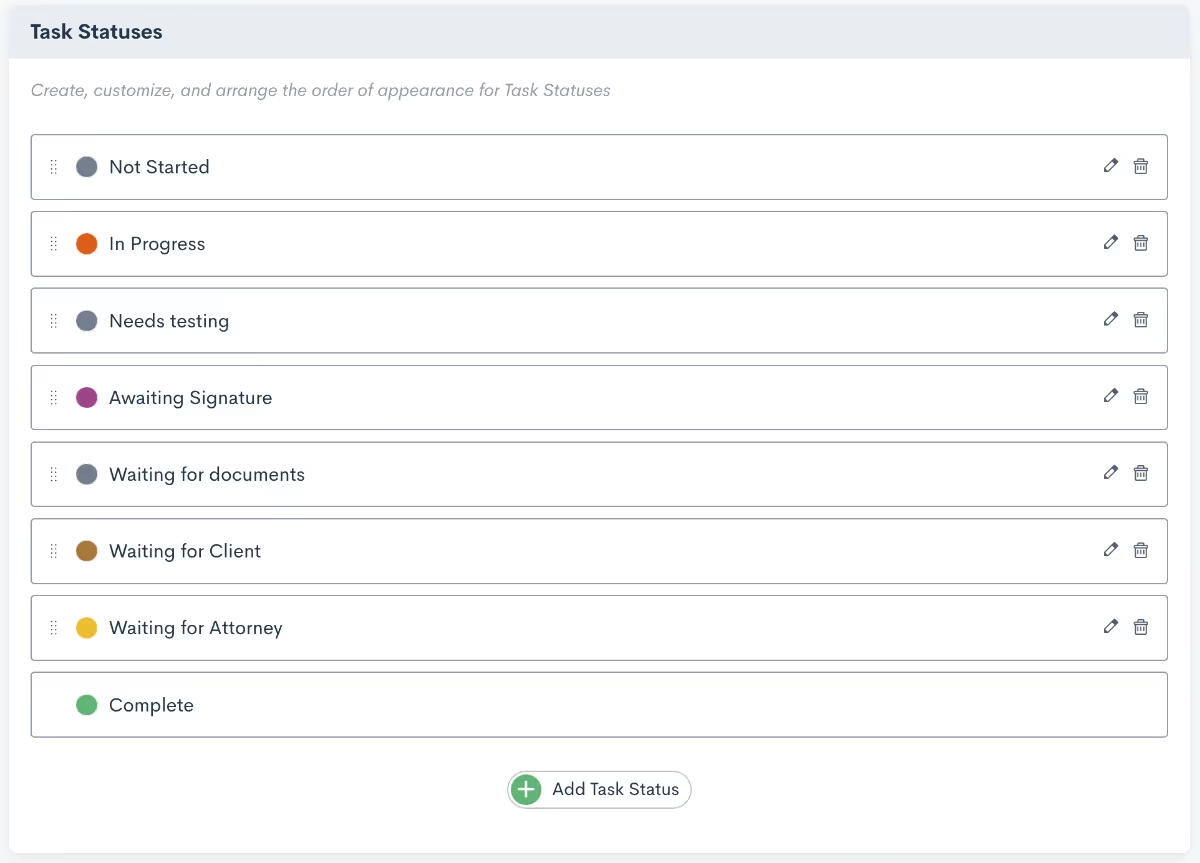
You can now create custom Task statuses in Lawmatics to further organize your Tasks in alignment with your unique operational processes. This update comes on the heels of our newest default Task Statuses such as Not Started and Waiting on Client. To create a custom Task Status, navigate to the Tasks page from the Settings menu.Learn more about custom task statuses here.
Sub Tasks
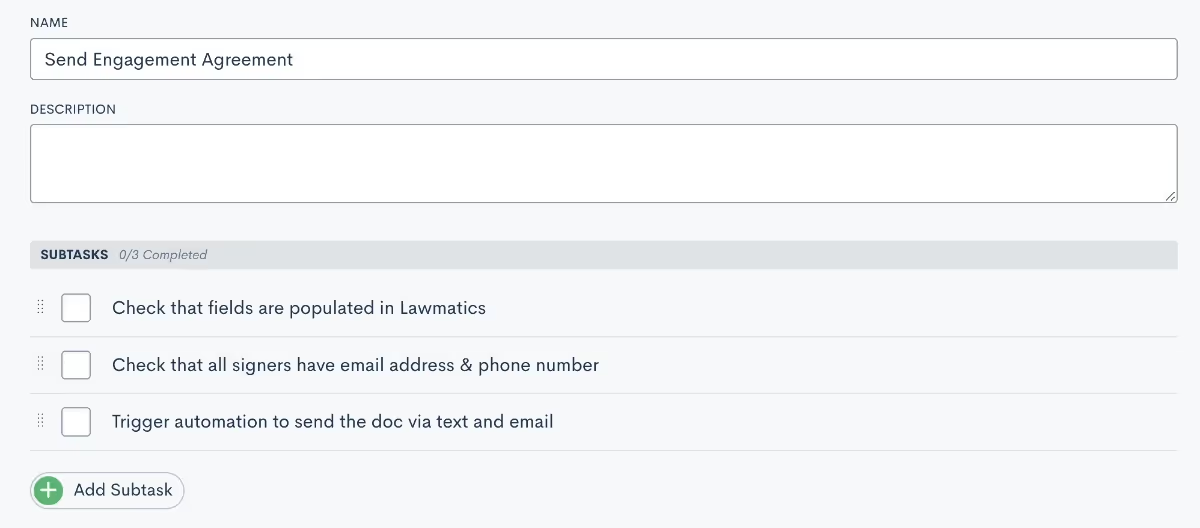
Any Task for which the work needs to be divided into smaller parts can now be broken up into Sub Tasks. Within any Task, simply click + Add Subtask and enter a brief task description. This enables your staff to easily check off each step as they work their way through a Task. Firms also have the option to toggle a setting so that automatically marks a Task as complete once all Sub Tasks are completed.Click here to read all about creating tasks.
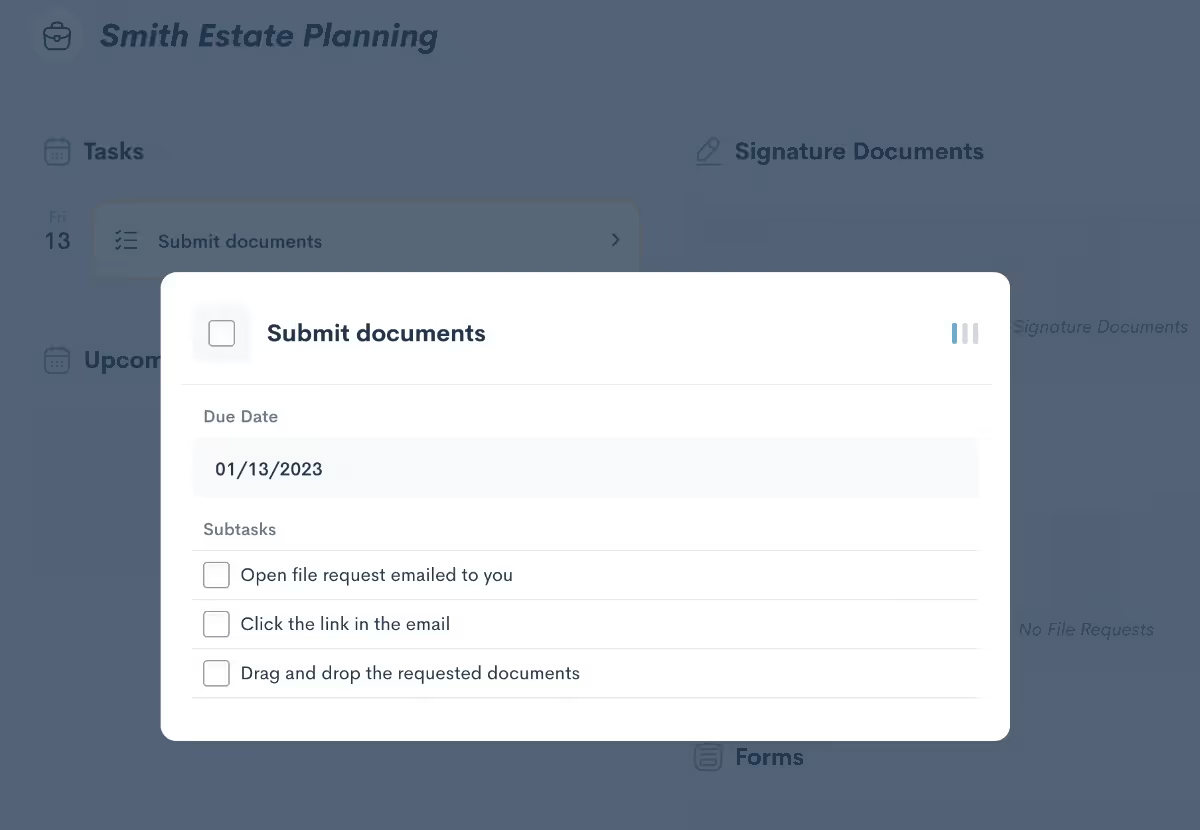
Get a refresher on using the client portal here.
Comment Thread on Tasks
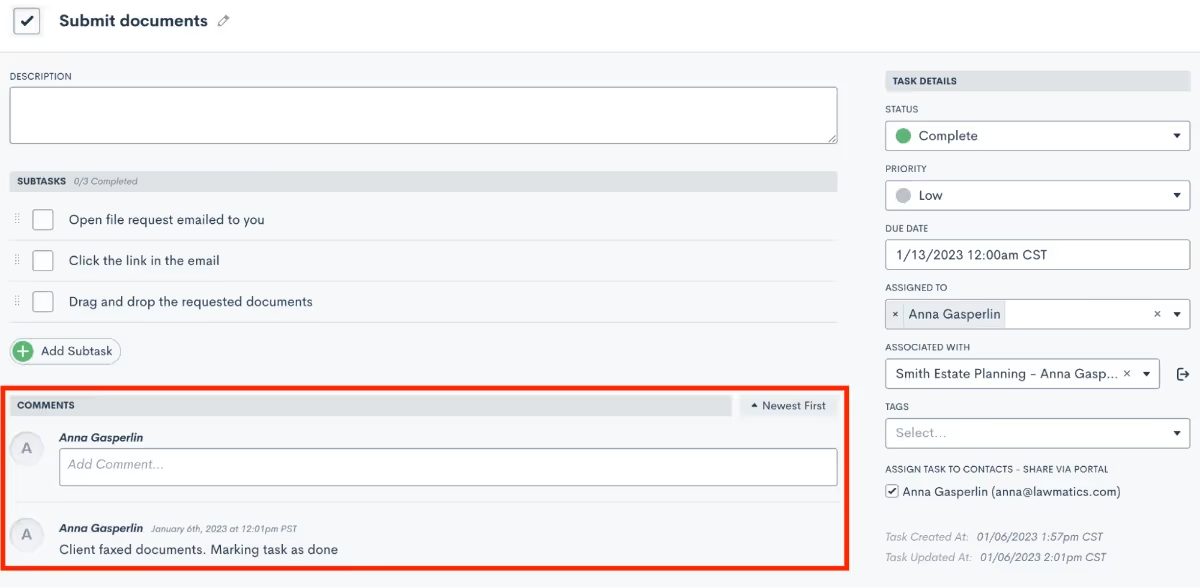
To ask questions, request extra information, or offer insight on an open Task, you can now add comments. Each comment logged within a Task is timestamped for future reference. Comments also denote which user left the comment, which comes in handy for Tasks that involve multiple collaborators. In addition, new notification options are available for Task comments so that no critical updates slip through the cracks.
@ Mentions in Task Comments
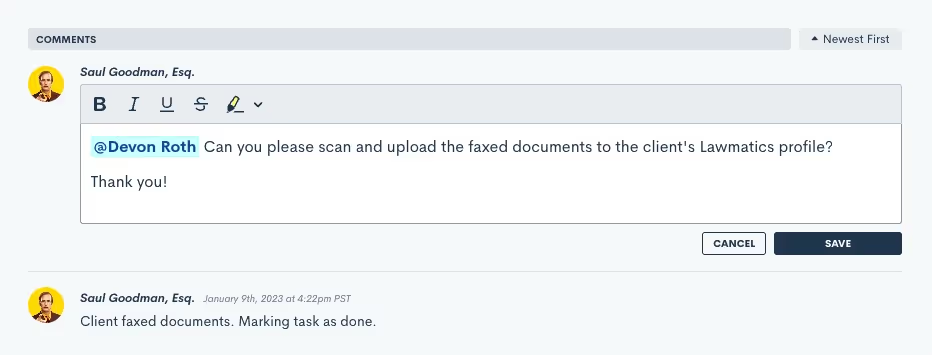
Want to leave a comment that pertains to a specific colleague? Simply type the @ symbol to select any users you’d like to tag in the comment. This is a great tool for making sure the correct person doesn’t miss any updates on action items that involve them specifically.Learn more about task comments and mentions here.
Notifications for @ Mentions in Tasks

In tandem with @ mentions in Tasks, we’ve also added a new notification option for Task comment mentions. Toggle on notifications to be notified when a fellow staff member tags you in a comment.Click here to learn about all of the notification options in Lawmatics.
Bonus Additional Features!
Custom Field Sync to Smokeball
We are thrilled to share an update to one of our most popular integrations. You can now sync Custom Fields to Smokeball via the Lawmatics integration. Whereas previously only a selection of default standard fields could be mapped from one platform to the other, you can now select any of your custom fields to map to a Smokeball field.Learn all about the Smokeball integration here.
Batch Invoicing

Collecting payments just got even easier with the addition of Batch Invoicing. For clients who have more than one ongoing matter with your firm, you can now send invoices for all of their matters in one batch. This allows them to receive all of their invoices for multiple matters in one email, making it easy for them (and you) to manage all invoices. We’ve also given you the option to create a custom email template specifically for batched invoices, providing extra clarity to the billing process for your clients.Read up on Lawmatics time tracking & billing here.
Even more new features we’re excited about!
- Subscribe to reports and receive an automatic email containing a summary of the report as well as an exported CSV file of said report
- Create matter file folders via automation
- Audiences will now automatically filter out contacts who don't have an email or have unsubscribed
If better organized internal communication is a new year’s resolution for your firm, this latest feature release will help you do just that. We’d love to hear your thoughts on how tasks have helped your firm, share with us at support@lawmatics.com!
Subscribe to get our best content in your inbox
Ready to grow your law firm with Lawmatics?
Schedule a demo of legal’s most trusted growth platform.
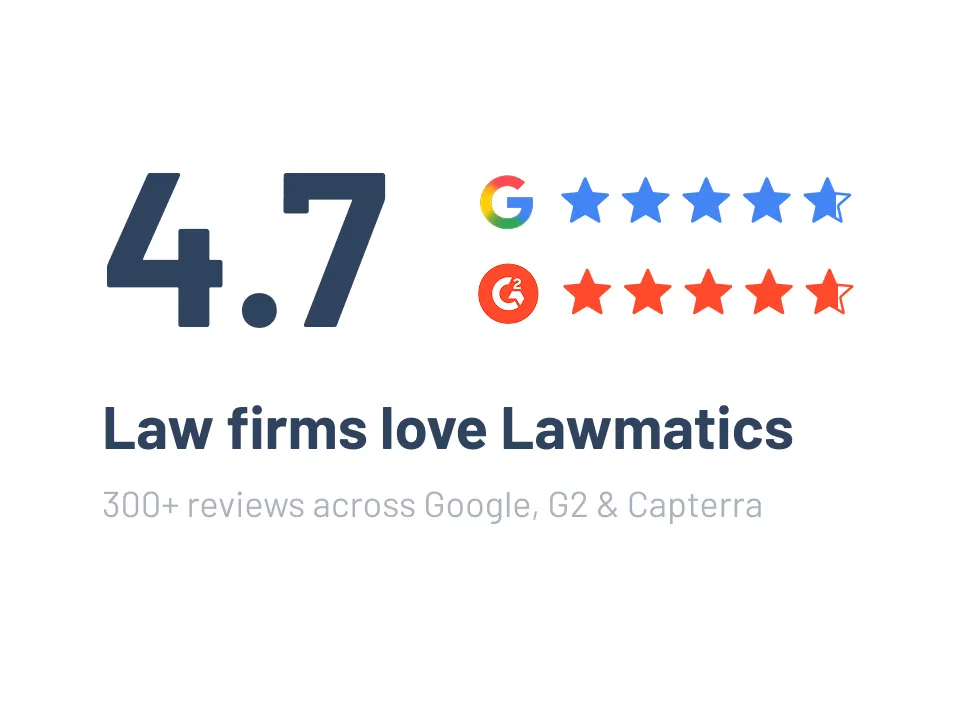




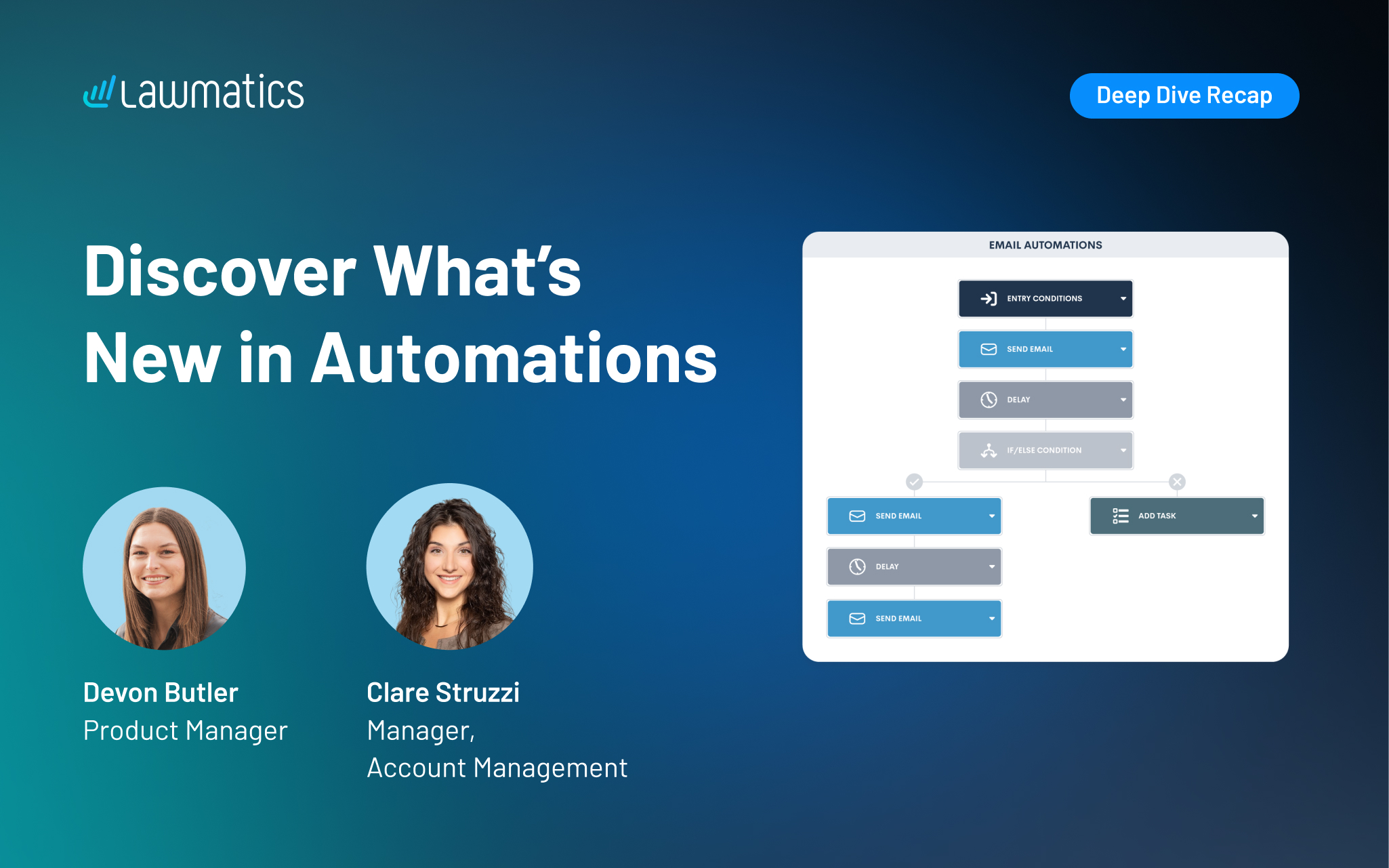




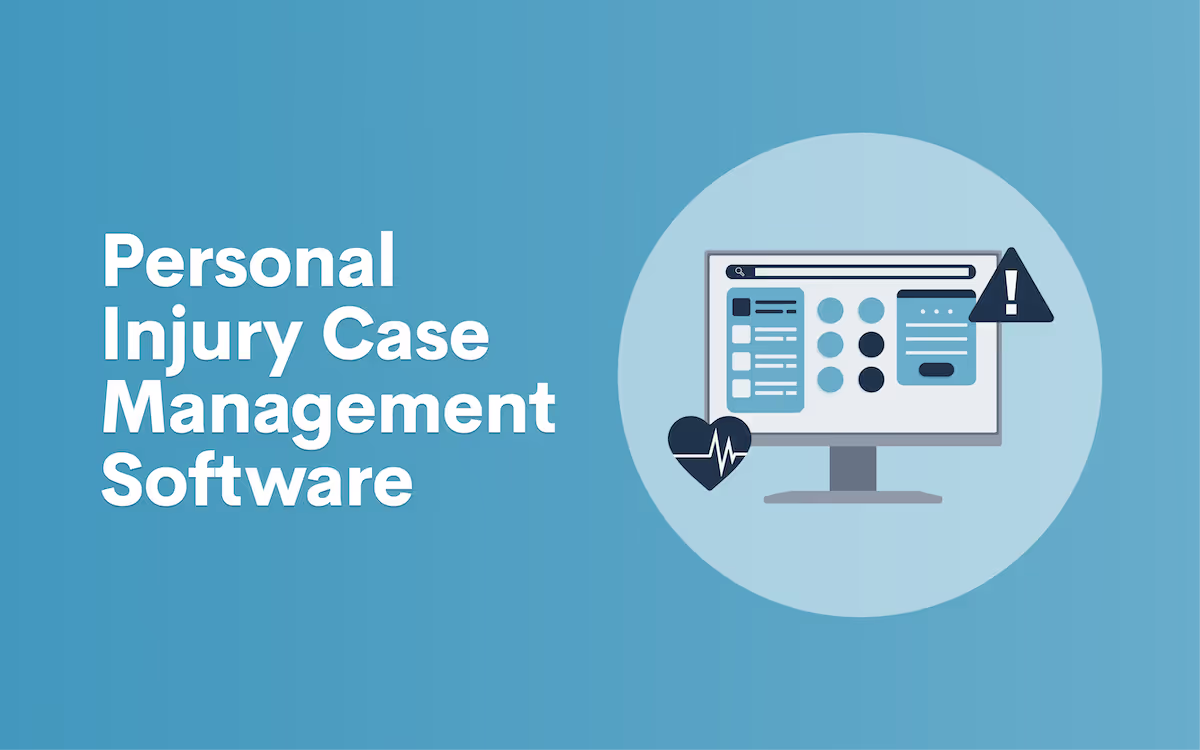


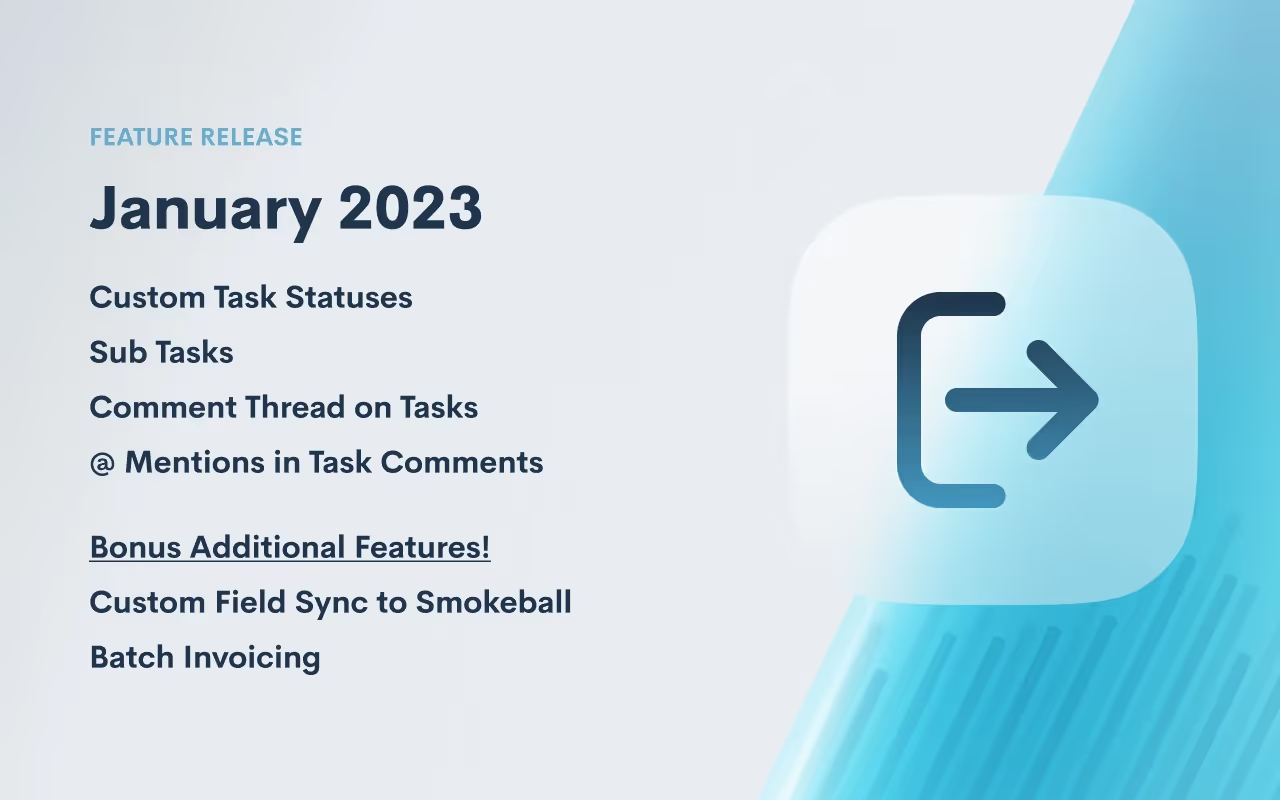
.avif)
.avif)

.avif)
